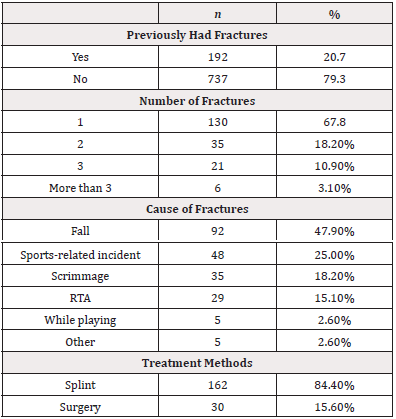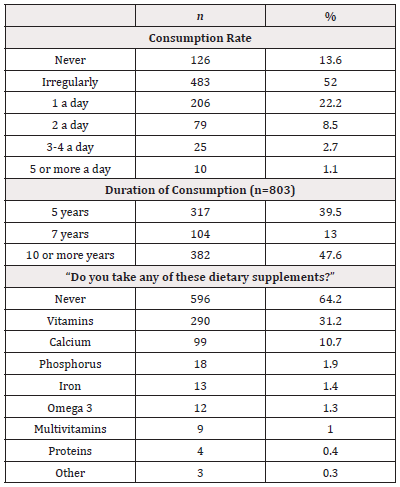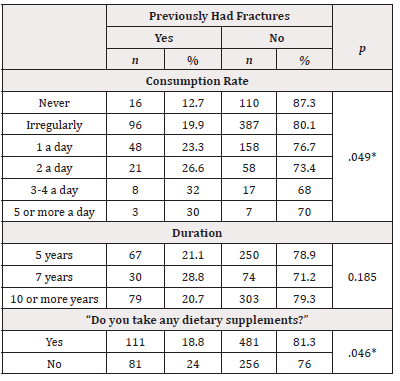Research Article 
 Creative Commons, CC-BY
Creative Commons, CC-BY
The Association Between Soft Drinks Consumption and Frequency of Bone Fractures Among Young Adults in Western Region of Saudi Arabia: A Cross-Sectional Study
*Corresponding author: Abdolkaliq Almatari, Sixth-year medical student, Faculty of medicine Umm Al-Qura University.
Received: June 10, 2024; Published: June 13, 2024
DOI: 10.34297/AJBSR.2024.22.003023
Abstract
Background: Soft drinks are any consumable, carbonated, non-alcoholic, water-based beverage with high free sugar. Over the past decade, the consumption of soft drinks has been increasing. The association between high soft-drink consumption and increasing frequency of bone fractures has not been well investigated, especially in Saudi Arabia.
Aim: This study aimed to measure the association between soft-drink consumption and the frequency of bone fractures among young adults in western region of Saudi Arabia.
Method: Three hundred forty-eight adults aged 18-25 years participated in a cross-sectional survey, data was collected using an online survey, The survey questionnaire was developed with reference to existing literature. Validation of the survey was conducted in consultation with orthopedic surgeons. The survey was presented in the Arabic language.
Results : The participants’ ages ranged from 18 to 25 years (M=22.3±4), and 660 (71%) were female. Of the participants, 192 (20.7%) had previously had a fracture which was once among 130 (67.8%) of them, 2 or more among 62 (32.2). The most-reported cause of fractures was falling (47.9). As for soft drinks, 126 (13.6%) of the participants had never had them, 483 (52%) had them irregularly, 206 (22.2%) had one a day, and 114 (12.3%) had two or more a day. Three hundred eighty-two (47.6%) had consumed soft drinks for 10 or more years. The p-value for the association between soft-drink consumption and bone-fracture frequency was 0.240.
Conclusion: The association between soft-drink consumption and bone-fracture frequency was insignificant. Future researchers should use more useful methods, like measuring bone density or designing a retrospective study.
Introduction and Rationale
In 2010, 6.8% of the world’s total disability-adjusted life years were caused by musculoskeletal disorders [1]. Accidental falls and hits are the primary direct causes of fractures, but low bone mass and excessive bone resorption are the fundamental causes. An unhealthy lifestyle is linked to bone fractures. Moreover, diet has a significant role in bone health. The relationships between specific foods in diets and bone fractures have not been well investigated. Soft drinks are any consumable, non-alcoholic, water-based beverages with high free sugar [2], are common in the modern diet [1]. Soft-drink consumption has increased globally, particularly among younger populations; thanks to widespread advertising and availability in supermarkets, convenience stores, and grocery stores, all age groups now have access to these drinks [3]. The World Health Organization (WHO) advises maintaining consumption of foods and beverages with added “free sugars” to less than 10% of total calorie intake [4]. Despite this, in the US, soda consumption is very high [5], and the rise in sugar consumption through beverages and the associated harmful health implications are concerning [2]. The ability of sugar consumption to cause disease and long-term health impacts has drawn attention from scholars [6]. Large quantities of free sugars and high intake of soft drinks increase the risk of developing chronic diseases like obesity and diabetes [1]. In fact, over the past 20 years, several epidemiological studies have examined the relationship between soft drinks and weight gain and obesity among adults and children [7]. Bone metabolism can be affected by interfering with calcium absorption and equilibrium in the body and causing an increase in calcium excretion through urine [2].
High soft-drink consumption has been linked to reduced bone mineral density in teenagers [5] and can lead to tooth decay and erosion as well as health issues like cardiovascular and neurological diseases [8]. Further, high soft-drink consumption can cause hip fractures, which are predicted to become more common worldwide by 2025, by up to 250% in men and 220% in women [5]. A crucial phase for bone formation is during the aldosterone health period. Small-scale studies suggest that excessive use of soft drinks, especially colas, during this time may hinder the accumulation of bone minerals [9]. Overall soft-drink consumption has been linked to reduced Bone Mineral Density (BMD) in teenagers [5]. Future public health may face a serious threat if consumption remains high while BMD declines. Many researchers have examined how carbonated beverages affect teenage fractures [1]. Numerous studies have been conducted to determine how soft-drink consumption affects bone health [2]. In 2021, a meta-analysis showed that consuming soft drinks, such as carbonated beverages, was inversely related to BMD in adults [7]. Another study in Ireland demonstrated that soft-drink consumption is be negatively correlated with BMD [9]. Another study in China examined the relationship between soft-drink consumption and fracture incidence and found that fractures are directly correlated with soft-drink consumption. The researchers suggested that reducing soft-drink consumption should be considered to maintain bone health [1]. However, no studies have examined the connection between soft drinks and fractures in western Saudi Arabia. Thus, we sought to evaluate the potential relationship between routine soft-drink consumption and fracture risk among young adults in this area.
Methods
A cross-sectional survey was done at Umm Al-Qura University in Makkah from October 2022 to March 2023. The target sample was young adults aged 18-25 from western region of Saudi Arabia. They were divided into groups based on how frequently they consumed soft drinks. Young adults from other regions of Saudi Arabia, who had chronic diseases, or who declined to participate were excluded from the study.
Sample
The number of participants in the study needed to be 384. The Sample size as calculated by EPI info software VER 2.1, considering a confidence interval of 95% and a significance level of 5%. The participants were recruited using a non-probability sampling technique.
Data-Collection Tools
Data was collected using an online survey. The survey had 18 questions, which were divided to five sections. Section 1 (Q1) was an online informed consent. Section 2 (Q2) determined the number of the data collector. Section 3 (Q3-Q10) captured sociodemographic information, basic academic details, smoking status, BMI, and health status. Section 4 (Q11-Q15) asked for information about fractures and treatment. Section 5 (Q16-Q18) asked for information about soft-drink consumption. The idea of the survey was taken from published literature, and the validation method was taken from consultant’s orthopedic surgeons. The survey was published in Arabic. Ethical approval for this study was granted by the biomedical ethics committee of UQU, approval no. (HAPO-02-K-012-2022-11-1330). The participants were informed of the study objectives and consented to participating at the beginning of the study.
Survey Development
The survey questionnaire was developed with reference to existing literature [1]. Validation of the survey was conducted in consultation with orthopedic surgeons. The survey was presented in the Arabic language to cater to the local population
Results
Participant Demographics
A total of 929 young adults completed the survey. The participants’ ages ranged from 18 to 25 years, with a mean age of 22.3±2.4. Of the participants, 660(71%) were female, and 269(29.0%) were male. Regarding BMI, 114(12.3%) were underweight, 190(20.5%) were overweight, and 165(17.8%) were obese. Regarding education level, 593(63.8%) were university graduates or had post-graduate degrees, 314(33.8%) had secondary-level education, and 22(2.4%) were educated below the secondary level. A total of 161(17.3%) were smokers. Regarding physical activity, 268(28.8%) had never engaged in physical activity, 222(23.9%) engaged once a week, 200(21.5%) engaged twice a week, and 239(25.7%) engaged three or more times a week (Table 1).
History and Causes of Fractures Among Young Adults
Of the 929 participants, 192(20.7%) had previously had fractures-once for 130(67.8%), twice for 35 (18.2%), and three or more times for 27(14%)-and 737(79.3%) had not. The most reported causes of fractures were falling (92[47.9%]), sports-related incidents (48[25%]), scrimmages (35[18.2%]), Road traffic accident (29[15.1%]), while playing (5[2.6%]), and other (5[2.6%]). A total of 162(84.4%) adults with fractures were treated using splints, while 30(15.6%) underwent surgery (Table 2).
Consumption of Soft Drinks and Dietary Supplements Among Young Adults
As for soft drinks, 126(13.6%) of the participants had never had soft drinks, 483(52%) had soft drinks irregularly, 206(22.2%) had one soft drink a day, 79(8.5%) had soft drinks a day, and 35(3.8%) had more than two a day. In terms of duration, 317(39.5%) had consumed soft drinks regularly for 5 years, and 382(47.6%) had done so for 10 years or more. As for dietary supplements, 290(31.2%) participants used vitamins, followed by calcium (10.7%), and 596(64.2%) had never had dietary supplements (Table 3).
Soft-Drink Consumption and Frequency of Bone Fractures
Fractures were reported among 30% of the participants who had soft drinks five or more times a day and among 19.9% of those who had soft drinks irregularly; 12.7% of those who did not have soft drinks with recorded statistical significance (p=.049). Further, 24% of those who did not use dietary supplements experienced bone fractures, compared to 18.8% of those who did use dietary supplements (p=.046; Table 4).
Factors Associated with Frequency of Bone Fractures Among Young Adults
Bone fracture was reported among 36.4% of male participants and 14.2% of female participants (p=.001). Further, 26.7% of smokers had bone fractures compared to 19.4% of non-smokers (p=.037; Table 5).
Discussion
The purpose of this study was to investigate the association between soft-drink consumption and frequency of bone fractures among young adults in western Saudi Arabia. The study demonstrates that high consumption of soft drinks is not associated with high frequency of bone fractures among this group. In this study, we found that 47.6% of adults have consumed soft drinks for 10 or more years. In addition, we found that 12.3% of participants have more than one soft drink daily. Furthermore, many factors were included in our study, and their relation to fracture frequency were examined. For example, 21.6% of participants 24-25 years old had fractures, while 78.4% of participants had never had a fracture. In contrast, participants 18-23 years old reported fewer fractures. Therefore, we conclude that age may be a factor in increasing the risk of having fractures. Moreover, the results showed that males are at greater risk of having fractures (36.5%) compared to females (14.2%). Further, smoking is an important factor that increases the risk of fractures, as 26.7% of smokers had fractures, and 19.4% of non-smokers had never had fractures. Lifestyle also has a great effect on fracture frequency. We found that participants who were physically active more than three times per week had a higher chance of having fractures (23.5%) compared to people who were less active (19.3%). We also found that people who take daily supplements have lower incidence of fractures (18.7%) than people who do not take supplements (24%). Approximately 25% of people who consume soft drinks five or more times per week reported a history of fractures, while 75% did not have a history of fractures.
Unexpectedly, our findings showed no association between soft-drink consumption and the frequency of bone fractures among young adults, compared to studies conducted in China and Qatar, they found that daily soft-drink consumption was associated with a doubled risk of fracture regardless of sociodemographic characteristics and there was a strong correlation with decreased BMD in postmenopausal women [1,10]. Another study that included 161,808 postmenopausal women showed that heavy soft-drink intake was associated with a mildly elevated incidence of hip fracture [11]. A meta-analysis study conducted in 2021 showed that SSB consumption, such as carbonated beverages, was inversely associated to BMD in adults [2]. The variation in results may have been due to multiple hypotheses, such as a small sample size compared to previous research. In addition, the participant included in the present study were young adults, unlike other studies, in which the participants were older people and post-menopausal women. Furthermore, in the Qatar study, the researchers used DEXA scan, which is more accurate than a survey-based study. We believe that the reason why we did not find an association between soft-drink consumption and frequency of fracture is that soft-drink consumption has an accumulating effect that appears in the last decades of people’s lives. To conclude, this study emphasizes the effect of soft-drink consumption on bone health by exploring the associations between soft-drink consumption and frequency of bone fractures. The results show that about 30% of participants consuming soft drinks five or more times a week have a history of fractures. In our study, there was no association found between soft-drink consumption and the frequency of bone fractures.
There were several limitations in this study. First, the small sample size may have lead to incorrect associations. Second, the study was observational, as it depended on the participants’ ability to recall and report intake. This may have introduced recording errors and recall bias. Third, we did not have an objective measurement, such as BMD. Fourth, all participants were chosen from western region of Saudi Arabia, making it difficult to generalize our findings. Fifth, our study sample was selected based on voluntary participation, which may have introduced selection bias, resulting in overestimating or underestimating the association between soft drinks and fracture frequency. Sixth, the site of the fracture was not reported. Lastly, we did not have information about the types of soft drinks (i.e., carbonated or non-carbonated) and thus could not assess the association between types of soft drinks and fractures. Soft-drink consumption has been increasing significantly over the last three decades [12]. According to research conducted in Saudi Arabia, people are consuming soft drinks three times per day with meals. The effects of soft drinks are unknown, while epidemiological studies have related soft-drink consumption to obesity, osteoporosis, and renal and liver diseases [13]. Other research also show also there was a positive association between soft-drink consumption and the prevalence of CVD [14]. Soft-drink consumption induces bone fracture, interruption in bone formation, and changes in serum or urine calcium metabolism markers [13]. A worldwide effort has been made to minimize excessive soft-drink consumption through methods such as nutrition education and public awareness campaigns. We have established that these campaigns not only protect people from obesity, diabetes, and cardiovascular disease but also improve bone health [2]. For future studies, we suggest increasing the level of awareness about excessive consumption of soft drinks in Saudi Arabia. Further, more studies with larger samples and a broader age range are needed to show the relationship between soft-drink consumption and different health effects. If further cohort studies support this association, it may be possible to establish an acceptable public-health strategy to promote bone health through reduced soft-drink consumption.
Acknowledgements
None.
Conflict of Interest
None.
References
- Chen L, Liu R, Zhao Y, Shi Z (2020) High consumption of soft drinks is associated with an increased risk of fracture: A 7-year follow-up study. Nutrients 12(2): 530.
- Ahn H, Park YK (2021) Sugar-sweetened beverage consumption and bone health: a systematic review and meta-analysis. Nutr J 20(1): 41.
- Musaiger A, Zagzoog N (2014) Knowledge, attitudes and practices toward energy drinks among adolescents in Saudi Arabia. Glob J Health Sci 6(2): 42-46.
- Benajiba N, Mahboub SM (2019) Consumption of Sugar-Sweetened Soft Drinks Among Saudi Adults: Assessing Patterns and Identifying Influencing Factors Using Principal Component Analysis. Pakistan J Nutr 18(5): 401-407.
- Fung TT, Arasaratnam MH, Grodstein F, Katz JN, Rosner B, et al. (2014) Soda consumption and risk of hip fractures in postmenopausal women in the nurses’ health study. Am J Clin Nutr 100(3): 953-958.
- Gallagher JC (2019) Sodas and colas are associated with an increase in fractures. Menopause 26(11): 1229-1231.
- Malik VS, Pan AA, Willett WCWC, Hu FB (2013) Sugar-sweetened beverages and weight gain in children and adults: a systematic review and meta-analysis. Am J Clin Nutr 98(4): 1084-
- Tahmassebi JF, BaniHani A (2020) Impact of soft drinks to health and economy: a critical review. Eur Arch Paediatr Dent 21(1): 109-117.
- McGartland C, Robson PJ, Murray L, Cran G, Savage MJ, et al. (2003) Carbonated soft drink consumption and bone mineral density in adolescence: The Northern Ireland young hearts project. J Bone Miner Res 18(9): 1563-1569.
- Kerkadi A, Lathief S, Khial Y, Teleb T, Attieh G, et al. (2022) The Relationship Between Bone Mineral Density and Body Composition Among Qatari Women With High Rate of Obesity: Qatar Biobank Data. Front Nutr 9: 834007.
- Kremer PA, Laughlin GA, Shadyab AH, Crandall CJ, Masaki K, et al. (2019) Association between soft drink consumption and osteoporotic fractures among postmenopausal women: the Women’s Health Initiative. Menopause 26(11): 1234-1241.
- Nielsen SJ, Popkin BM (2004) Changes in beverage intake between 1977 and 2001. Am J Prev Med 27(3): 205-210.
- Alkhedaide A, Soliman MM, Salah-Eldin AE, Ismail TA, Alshehiri ZS, et al. (2016) Chronic effects of soft drink consumption on the health state of Wistar rats: A biochemical, genetic and histopathological study. Mol Med Rep 13(6): 5109-17.
- Fung TT, Malik V, Rexrode KM, Manson JE, Willett WC, et al. (2009) Sweetened beverage consumption and risk of coronary heart disease in women. Am J Clin Nutr 89(4): 1037-1042.








 We use cookies to ensure you get the best experience on our website.
We use cookies to ensure you get the best experience on our website.